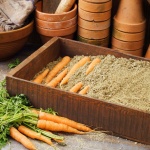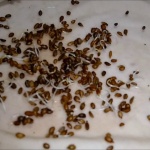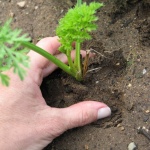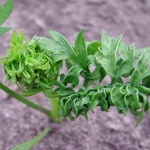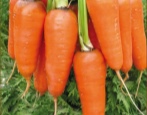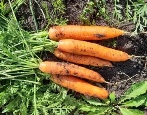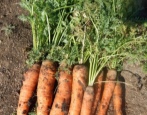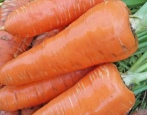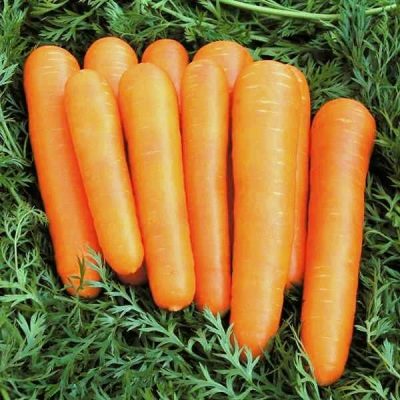
- Authors: Vinogradov Z.S., Semin A.S.
- Year of approval: 2010
- Appointment: for fresh consumption, for canning, for bundled products, for making juice
- Leaf rosette shape: semi-spreading
- Leaves: medium length, green to dark green, moderately dissected
- Weight, g: 90-130
- The form : cylindrical, slightly pointed tip
- Taste qualities: good ones
- Composition : dry matter 12.8-14.0%, total sugar 7.3-8.4%, carotene up to 17.9 mg per 100 g of raw matter
- Ripening terms: mid-early
Carrots are a very important and essential vegetable in baby food. In order for children to eat the vegetable with pleasure, it is necessary to select sweet and juicy varieties with a high content of vitamins and trace elements in the pulp. These include the mid-early variety Children's sweetness, which will not be difficult to grow in a garden bed if you familiarize yourself with the intricacies of care.
Breeding history
Children's sweetness is a variety obtained thanks to the long-term work of domestic breeders ZS Vinogradov and AS Semina in 2007 at the Russian Seeds CJSC. After 3 years (in 2010), the vegetable crop was entered into the State Register of Breeding Achievements of the Russian Federation. The vegetable is cultivated in the Central Black Earth region. Carrots are grown both on small garden beds and on farm plantations.
Description of the variety
This carrot variety is a plant with a powerful, erect semi-spreading deciduous rosette. The leaves of the tops are of medium length, reaching 20-25 cm, and a beautiful, emerald green color. The edge of each leaflet has medium cuts. The tops do not have a strong aroma. A distinctive feature is that the leaves do not turn yellow and do not dry out even after the root crop is completely ripe. The variety belongs to the Amsterdam variety.
Characteristics of the appearance of the plant and root crops
This variety belongs to the medium-fruit class. Vegetables ripen neat and aligned, almost all of the same size. The average weight of the fruit reaches 90-130 grams, and the length is up to 18-22 cm. In shape, the vegetable resembles an elongated cylinder with a slightly pointed end. The bark of the carrot is thin, smooth, with a noticeable shine, without flaws, with a small number of filamentous roots. Ripe roots are evenly colored red-orange.
The resulting crop can be easily transported and stored for a long time in a dry and cool place. Vegetables do not deform or crack during storage.
Purpose and taste of tubers
Children's joy is considered one of the sweetest and incredibly delicious carrot varieties. The red or red-orange pulp is endowed with a dense, fleshy, crispy, tender and very juicy consistency without bitterness and fiber. The taste is very sweet and sugary, complemented by a pronounced summer aroma. The core is very thin, completely indistinguishable from the pulp in color and structure.
A huge advantage of the variety is the composition of the pulp, which contains an increased amount of sugars, carotene, vitamins (B, B1, E, PP, C and B2), trace elements (iron, copper, fluorine, potassium, calcium, phosphorus).
Dug up roots have a wide range of uses in cooking - they eat carrots fresh, process them into puree and juices (baby food), pickle, freeze, add to hot and cold dishes, canned with vegetables, and the variety is ideal as a preparation for the winter.
Maturation
Children's joy is a bright and tasty representative of the group of mid-early carrot varieties. The growing season lasts from 95 to 110 days. You can taste the root vegetables in mid-July, but they are not yet gaining maximum sweetness and sugar content, and the massive harvest takes place in August-September.An absolutely ripe fetus is characterized by the presence of light hairs on the bark (filamentous roots).
Yield
The variety is distinguished by high yield rates. On average, 4-7 kg of juicy root crops can be dug out from 1 m2 of plantings. When growing a vegetable for commercial purposes, the average yield is 286-371 c / ha.
Growing and care
Grow Baby sweetness through the seeds. Often the best period for cultivation is considered the end of April - the beginning of May, when the air warmed up to + 7 ... 9 degrees. For this, elongated grooves with a depth of 1.5-2 cm are prepared on the site, where seeds are sown at a distance of 2 cm from each other. The distance between the rows is 18-20 cm. Planting is carried out according to the scheme 5 / 7x18 / 20 cm. It is best to plant carrots in the area where onions, garlic or legumes used to grow. It is not recommended to plant in the same place for several years in a row.
Podzimny sowing is carried out in late October - early November. In this case, the seeds are planted a little denser than in spring. In addition, the seed does not need pre-treatment.
The vegetable crop is not very demanding in care, but it needs basic procedures - weekly watering with warm / settled water (do not water it 2-3 weeks before harvesting), several thinning out while maintaining an interval between plants of 4-6 cm, regular weed removal, fertilization (two dressings are enough), loosening of the soil, prevention of diseases and insect attacks. In addition, periodic hilling of root crops is recommended.
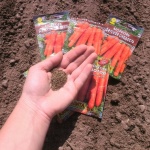
Carrots are one of the most unpretentious crops in terms of growing conditions; they can endure a short drought and a short cold snap. However, to get tasty and large root crops, you should adhere to the basic rules for planting carrots.

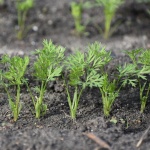
Soil requirements
The variety is quite demanding on the composition and structure of the soil. The vegetable grows comfortably in loose, breathable, moist and fertile soils with a neutral acidity index. Light loam and sandy loam with a high nutritional value will be optimal.
Required climatic conditions
Children's sweetness has good stress resistance. The variety is frost-resistant, easily tolerates short-term drought and short shade. In addition, he is not afraid of recurrent spring frosts and temperature drops to –3 ... 4 degrees. Carrots should be planted in a flat or slightly elevated area with enough sun, warmth and light.
Disease and pest resistance
The immunity of the culture is average, so it is necessary to carry out preventive measures to avoid diseases and pests. According to experienced vegetable growers, the variety is tolerant to the attacks of carrot flies and infection with root rot, phomosis.

Carrots grow in almost any garden. There is an opinion that this culture is very resistant to all kinds of diseases and pests, but this is not the case. Without proper care, carrots become susceptible to all kinds of infections and are affected by harmful insects.

